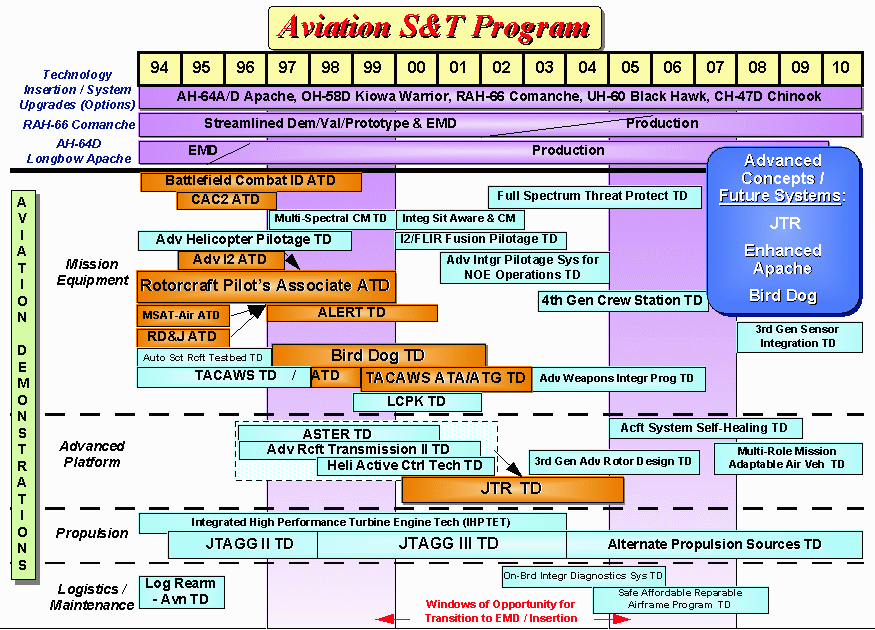 Introduction to Aircraft
Introduction to Aircraft Introduction to Aircraft
Introduction to AircraftU. S. ARMY
Aviation S&T Roadmap
VISION
Army aviation provides versatile, rapidly deployable, responsive forces that overcome the limitations of ground systems by easily negotiating terrain obstacles; expanding the battle space; massing the effects of fire without missing forces; and delivering precise, lethal fires. Army aviation forces operate with unmatched effectiveness throughout the range of military operations, and particularly in the Operations Other Than War (OOTW) category of operations. Army aviation forces provide combat, combat support, and combat service support to combined arms, joint, and coalition forces.
The aviation S&T program provides the underpinning for technology insertion and aircraft/mission equipment integration programs. It also develops the foundation for aviationís system upgrades and next-generation/future-systems capabilities to meet changing threats, mission requirements, and to support the modernization strategy.
FUTURE
In downsizing to a four corps/18 division (10 active, 8 reserve) Army, the need for a commensurate reduction in the aviation infrastructure is obvious. To accomplish this, the objective of the Army aviation modernization strategy is to reduce the size of the rotary and fixed wing fleets to four aircraft types each via the Aviation Restructuring Initiative (ARI). ARI is the "vehicle" by which the army intends to accomplish the reduction in fleet size and model types while maintaining the vital capabilities of the fleet. Upon downsizing, the rotary-wing fleet will consist of the following: AH-64D Longbow Apache; RAH-66 Comanche; UH-60 Black Hawk; and CH-47D Chinook.
The reduction in quantity and types of rotorcraft is depicted graphically in Figure 1. In streamlining the fleet, the U. S. Army modernization priorities are driven by four tenets as follow:

- Figure 1 -
The following lists the primary combat and combat support missions which Army aviation performs and will continue to perform in the future. Also listed are the platforms which will perform these missions in the future and those which currently perform them.
Attack Mission
Tactical Reconnaissance (Air Cavalry Squadrons):
Assault Mission
Medium Helicopter Mission
Fixed Wing Fleet. As a product of ARI, Army aviationís overall goal relative to the fixed wing fleet is to reduce the current number of models from 21 to 4, as depicted graphically in Figure 2.

- Figure 2 -
In maintaining the operational superiority necessary to prevail throughout the range of military operations, in the face of an ever-changing threat, the transfer of state-of-the-art technologies into current and future platforms drives the Armyís Research, Development, and Acquisition (RDA) strategy for aviation. The objective is to apply the limited available resources in a manner which maximizes return on investment.
The RDA strategy involves four process steps: sustain, improve, develop and procure, and retire aircraft. The first step evaluates the current fleetís capability to meet warfighting requirements. If the given platform meets required needs, the fleet is sustained by safety and RAM upgrades to achieve operational and supportability cost reductions and improved sustainability. The second step looks to improve existing systems to stay inside the opposing force capability through technology insertions. When neither upgrades nor technology insertions can provide required capabilities, or are too costly, new systems are developed and fielded. As this occurs, old and technologically obsolete aircraft are retired. Inherent in this process is the development of aviation science and technology (S&T) to enhance aviation capabilities in the next century, and provide the enabling capabilities for future systems.
The aviation S&T program provides the underpinning for technology insertion and aircraft/mission equipment integration programs. It also develops the foundation for aviationís system upgrades and next generation/future systems capabilities to meet changing threats, mission requirements, and to support the modernization strategy. In addition, through the tri-service Project Reliance, the aviation S&T program is the DOD lead focus for rotorcaft technologies. The aviation S&T strategy (Figure 3) shows the interrelationship among the aviation disciplines, Technology Demonstrations (TDs), and Advanced Technology Demonstrations (ATDs). The aviation S&T program addresses aeromechanics, flight control, structures, drive trains and

- Figure 3 -
propulsion, subsystems, weapons integration, aircrew-aircraft integration and man-machine integration, survivability/vulnerability/safety, and advanced concepts for DOD rotorcraft. It addresses these via application of DOD/NASA/academic resources, simulation, virtual prototyping, and integrated product and process development (IPPD). These approaches reduce risk, minimize costs, and enhance multi-service and dual-use applications derived from the aviation S&T program. Army aviation is preparing to meet tomorrowís challenges by modernizing forces, developing warfighting doctrine, and creating force designs flexible enough to win decisively across the full range of military operations. Aviationís lethality, versatility, and deployability offer the return on investment critical to the Armyís investment strategy and future mission successes.